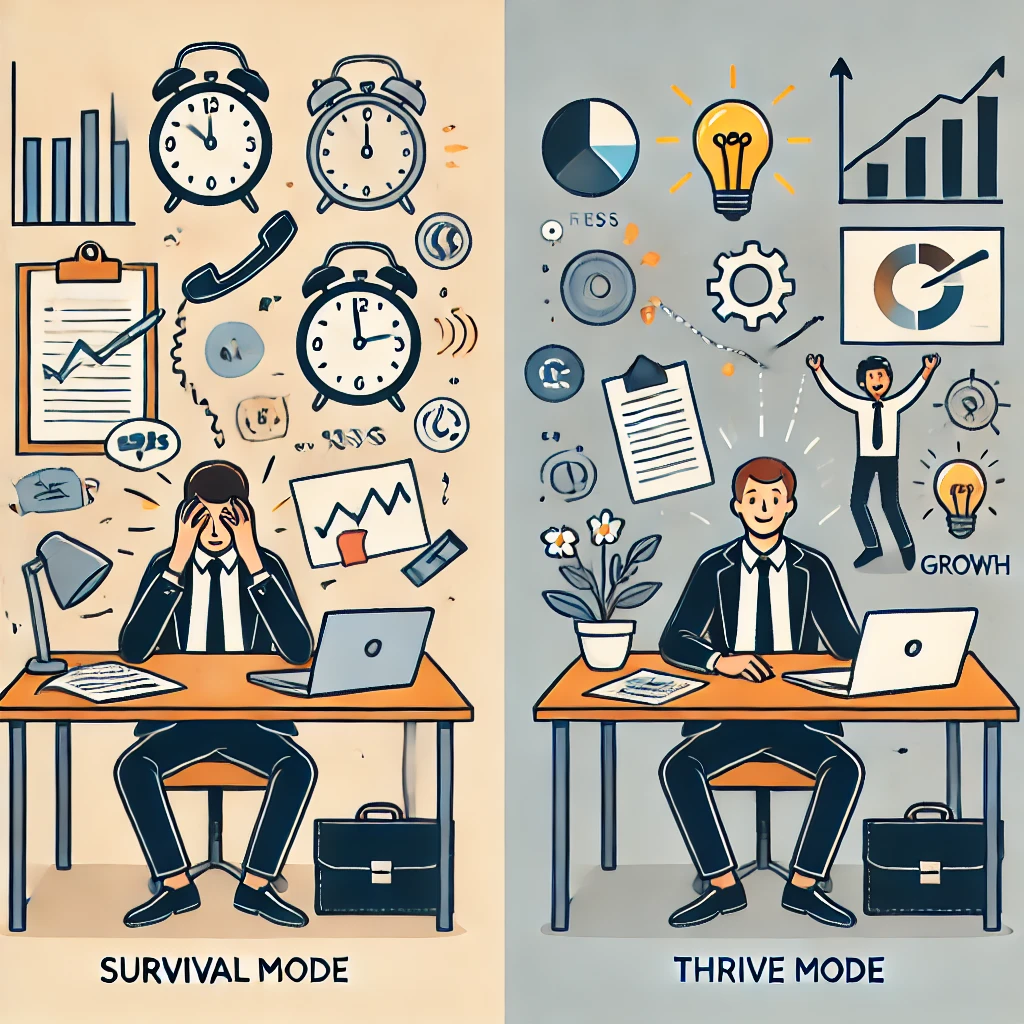 We’ve all had those days at work when everything seems like it’s on the verge of collapse. Deadlines are closing in, crises are erupting, and you’re just trying to make it through the day. In these moments, we slip into what’s known as “survival mode,” hyper-focused on immediate threats and putting out fires. But what if there was a better way? A mindset where your team can flourish, innovate, and build toward long-term success. Welcome to “thrive mode.”
We’ve all had those days at work when everything seems like it’s on the verge of collapse. Deadlines are closing in, crises are erupting, and you’re just trying to make it through the day. In these moments, we slip into what’s known as “survival mode,” hyper-focused on immediate threats and putting out fires. But what if there was a better way? A mindset where your team can flourish, innovate, and build toward long-term success. Welcome to “thrive mode.”
The “Survival” Brain: Where Stress Reigns Supreme
Picture this…It’s Monday morning. Your inbox is overflowing, your team is in panic mode, and a big presentation is coming up in two hours. It feels like you’re dodging bullets. This is when your brain shifts into survival mode.
From a biological standpoint, the survival brain is driven by the amygdala, the brain’s “fear center.” It’s that primal part of the brain that activates when we sense a threat, whether it’s a tiger in the wild (ancient version) or a harsh email from your boss (modern version). The goal here is simple, protect yourself at all costs. Here’s what happens in this state:
- Focus on Immediate Threats: Your brain locks in on short-term dangers, like missing a deadline or a client complaint. Long-term vision and creative thinking are pushed aside in favor of survival.
- Stress Hormones Flood the Body: Cortisol and adrenaline surge through your system, giving you the energy to act fast. However, too much of these hormones over time can impair decision-making, leading to rash, reactive behaviors.
- Narrowed Perspective: In survival mode, the brain sees the world in black-and-white, win or lose, succeed or fail. Risk-taking becomes the enemy, and innovation feels like too much of a gamble.
Survival mode can be helpful in short bursts, it’s how we respond to emergencies. But when entire organizations operate in survival mode for extended periods, creativity stalls, employee development takes a back seat, and growth slows to a crawl.
The “Thrive” Brain: Where Growth Takes Flight
Now, picture a different day. The sun’s shining, your coffee is perfect, and your team is buzzing with ideas. Instead of dodging bullets, you’re thinking about next quarter’s big project, brainstorming new strategies with your team, and feeling energized by the possibilities. This is “thrive mode.”
The thrive brain taps into the prefrontal cortex, the brain’s executive center, responsible for planning, problem-solving, and emotional regulation. This part of the brain allows us to think beyond the immediate concerns and focus on long-term opportunities. Here’s what happens when the brain thrives:
- Focus on Growth and Opportunities: Rather than zeroing in on immediate threats, the thrive brain allows us to explore new ideas, consider multiple possibilities, and push boundaries. This is where innovation happens.
- “Feel-Good” Hormones: Chemicals like dopamine, serotonin, and oxytocin flood your brain, promoting feelings of well-being, motivation, and social bonding. This cocktail of “feel-good” hormones drives creativity, collaboration, and forward-thinking.
- Broad Perspective: In thrive mode, the brain can see the bigger picture and develop long-term strategies. Challenges are seen as opportunities to learn and grow, rather than obstacles to be avoided.
The thrive brain is where leaders and teams should aim to spend the majority of their time. It’s where personal and organizational growth happen, where innovation takes off, and where a business can truly excel.
How to Shift from Survive to Thrive 
Shifting from a survival mindset to a thriving one isn’t always easy, especially in high-pressure environments. However, with intentional practices, you can move from “just getting by” to leading your organization into a space where growth, creativity, and engagement flourish.
Here are some practical tips:
- Create a Pause Button:
- In stressful moments, your brain wants to react quickly. Instead, pause. Take a few deep breaths or step away for a moment. This simple act calms the amygdala and allows your prefrontal cortex to engage. When you calm your stress response, you can make decisions that align with long-term growth rather than just immediate survival.
- Shift the Focus to Long-Term Goals:
- When you find yourself stuck in survival mode, reconnect with your broader mission. Ask yourself: What’s the big picture? How does today’s challenge align with our long-term vision? Shifting your perspective away from immediate fires helps your brain break out of survival mode and think about growth opportunities.
- Celebrate Wins (Even the Small Ones):
- Thriving isn’t just about the end game; it’s about recognizing progress along the way. Whether it’s your team hitting a milestone or a creative idea from a junior employee, celebrating these wins fosters a thriving culture. It shifts focus from what’s going wrong to what’s possible.
- Empower and Trust Your Team:
- Survival mode can make you feel like you need to control everything. In thrive mode, leadership means trust. Delegate tasks, empower your team to make decisions, and trust their expertise. When employees feel empowered, they’re more likely to take initiative, think creatively, and drive the business forward.
- Set Attainable Goals:
- A survival mindset often leads to overpromising and under-delivering because you’re caught in reactive mode. Break this cycle by setting realistic, bite-sized goals. Achieving these goals builds confidence and momentum, helping shift from reactive behavior to proactive, strategic thinking.
- Build Resilience:
- Thrive mode doesn’t mean everything is perfect. It means being resilient when things go wrong. Build resilience by embracing adaptability and preparing for challenges. A resilient mindset sees setbacks as learning opportunities rather than threats, keeping you in thrive mode even during tough times.
The Bigger Picture: Moving Beyond “Good” vs. “Bad”
It’s easy to moralize these two mindsets. Thriving is seen as “good” and surviving is seen as “bad.” But the truth is, both mindsets have their place. Survival mode is necessary during critical deadlines or crisis management. The key is recognizing when you’re stuck in survival mode unnecessarily and taking conscious steps to shift into a thriving mindset.
By understanding the difference between these two states and applying intentional strategies, organizations can unlock their full potential. Thriving goes beyond just reducing stress or making people feel good, it’s about creating a culture that encourages innovation, long-term success, and promotes the growth of both the business and its people.















0 Comments